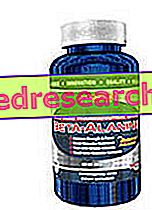The diet for high diabetes is a diet indicated to restore or maintain the balance of blood sugar.
Blood glucose is the amount of glucose diluted in blood plasma, which is measured in milligrams on deciliter (mg / dl) or millimoles per liter (mmol / L).
Diabetes
What is diabetes?
Definition of diabetes
Diabetes means a syndrome that includes a group of metabolic diseases characterized by a defect in the secretion and / or action of insulin, the presence of hyperglycemia and the long-term appearance of chronic complications at the level of various organs, in particular eyes, kidney, nerves, heart and blood vessels.
Classification
- Type I diabetes: characterized by the destruction of pancreatic beta cells, resulting in an absolute defect of insulin (also called juvenile diabetes)
- Type II diabetes: characterized by the defect of insulin secretion associated with insulin resistance (also called senile diabetes)
- Gestational diabetes - GDM: any form of impaired glucose tolerance that occurs during pregnancy.
NOTE
Any form of diabetes may require insulin therapy at any stage of the disease. The use of insulin by itself does not classify the patient or the pathology.
Diabetes insipidus has nothing to do with glucose metabolism and affects the secretion of vasopressin hormone (ADH or antidiuretic hormone).
Differences
Type 2 and gestational diabetes mellitus (also thanks to certain drugs) can stabilize, improve and even heal (depending on the case); however, they need a fairly specific and effective diet.
Let's not forget that:
- The worse the glucose metabolism (which causes hyperglycemia), the more severe the diabetes becomes and the greater the possibility of serious complications (protein glycation, neuropathies, vasculopathies, atherosclerosis, etc.).
Type 1 diabetes mellitus, on the other hand, being unable to heal, simply requires calibrating the amount of insulin (to be injected) according to the dietary carbohydrates.
Symptoms of diabetes
Type 2 diabetes mellitus does not always have obvious symptoms, at least in principle.
Due to severe hyperglycemia, various general feelings of malaise may appear (tiredness, dry mouth, frequent urination, etc.).
The first specific clinical signs are generally associated with nerve and bloodstream complications; this indicates that the disease has been present for a long time or that it is very serious.
Causes
The different types of diabetes have different causes.
- Everyone can have an inherited genetic basis, although of a specific and different kind
- Type 1 diabetes mellitus is characterized by the loss of some specific cells of the pancreas gland. It is typically autoimmune, but there are sporadic cases of surgical induction, mechanical injury, poisoning, etc.
- Type 2 diabetes mellitus often has causes attributable to lifestyle. In particular:
- An excessive and / or unbalanced diet, particularly rich in foods with a high content of carbohydrates, especially refined and with a high glycemic index
- Overweight (often severe)
- A sedentary lifestyle.
- Gestational diabetes also has a very important food and behavioral component; are more exposed to this dysmetabolism (which can cause serious damage to the fetus and become chronic even after childbirth):
- Obese and / or women
- that they feed without control during pregnancy.
Diet and Therapy
Importance of the diet for the treatment of type 2 diabetes
The diabetes diet is an appropriate nutritional regime that meets the guidelines in force.
The diet for diabetes is one of the fundamental cornerstones in the treatment of type 2 mellitus.
The role of nutrition in the treatment of this diabetes is so important that in this regard doctors prefer not to talk about diet, but about real "medical nutritional therapy for diabetes" (diet therapy).
Those who suffer from diabetes should therefore strive to scrupulously respect the few rules that we will see below.
These recommendations, seen from a preventive point of view, follow exactly those indicated in the healthy population to decrease the risk of developing diabetes and many other diseases, such as cardiovascular disease and some forms of cancer.
This does not mean that, in the case of pre-existing illness, metabolic benefits can be obtained.
Objectives of the diabetes diet
Introduction
Contrary to what many believe, the ideal diet of the diabetic is not at all complex or restrictive. In fact, for most people the diet is simply adapted to the illness, which is certainly not distorted.
Although some foods should be consumed in moderation, there is a wide range of healthy alternatives among which the diabetic can choose.
Diet goals
The main goals of the diabetes mellitus therapy diet are:
- Glycemic control
- Body weight control
- Lipidemia control.
- The prevention and treatment of risk factors or complications related to nutrition.
Dietary therapy is very similar in the two types of diabetes although:
- For type 1 diabetics, more attention must be paid to the intake of food, especially carbohydrates. The diet should limit simple carbohydrates as much as possible and provide regular and fractionated intake of complex carbohydrates. The primary objective is the maximum reduction of drug units and the normalization of the glycemic framework.
- For type 2 diabetics, often overweight, the diet will have to be calibrated in such a way as to favor the reduction of body weight up to acceptable levels.
Naturally the diet will have to take into account individual tastes and preferences.
Drugs associated with diet
The drugs most used in diabetes therapy are:
- For type 1 diabetes mellitus: synthetic insulin, to be injected (or administered automatically by innovative devices)
- For type 2 diabetes mellitus:
- Insulin stimulants
- Insulin tissue sensitizers
- Reducers of neoglucogenesis
- Reduce intestinal glucose uptake.
Dietary supplements
The supplements to be associated with the diabetes mellitus diet are mainly useful for type 2 therapy.
They are mainly used products with hypoglycemic abilities, that is that (differently depending on the active principle):
- They reduce the glycemic index (slowing down digestion and absorption); for example the fibers of psyllium (mucilage) or guar (gum) seeds.
- They reduce the glycemic load (hindering the digestion and absorption of carbohydrates); for example, acarbose.
Insights
Nutrition
Diet, diabetes and carbohydrates Diet, diabetes and proteins Diet, diabetes and fats Diet, diabetes and cholesterol Diabetes and fiber, vitamins and minerals Diet, diabetes and salt Diet, diabetes and alcoholWHAT TO EAT
Example Diet for Diabetes Mellitus type 2Diabetes: Which vegetables to choose? Carrots and diabetes Fruit and diabetes Bananas and Diabetes Pasta for Diabetics Alcohol and Diabetes Wine and Diabetes Honey and diabetes Fructose and diabetes Recipes for DiabeticsOther Types of Diabetes
Diet and Gestational DiabetesDiet and Diabetes Mellitus Type 1What to eat
Importance of carbohydrates
The quantity of carbohydrates and the type of foods consumed at each meal represents one of the most important aspects in the type 2 diabetes diet.
How many carbohydrates to eat in the diet for diabetes?
As anticipated, the total amount of carbohydrates to be consumed during the day should be around 50-55% of daily calories.
Those with a low glycemic index, associated with fiber will be preferred (in this case the carbohydrate share in the diet can reach 60% of total calories).
In general, it is advisable to keep the percentage of simple sugars below 10-12% (monosaccharides, such as fructose and glucose, and disaccharides, such as sucrose and lactose).
Saccharose, that is the normal cooking sugar, must not exceed 5% of the total calories (max 15-20 grams per day). This quantity can easily be exceeded by consuming sweets and / or some packaged products (biscuits, snacks, drinks etc. ), whose use must therefore be limited or better avoided.
For the same reason it is good to replace the sugar with sweeteners without nutritional value (approved by the FDA) absolutely free of risks for the patient.
Which food sources of carbohydrates are most recommended in the diet for diabetes?
The carbohydrate sources best suited to the diet against type 2 diabetes mellitus, in addition to being consumed in the right portions, must have the following characteristics:
- Low or medium maximum glycemic load
- Low or maximum average glycemic index
- Fiber richness, which reduces both the load and the glycemic index (for example, better the whole wheat flour than the refined one)
- Water richness, which reduces the glycemic load (for example, fresh fruit is better than the dehydrated one)
- Presence of proteins and fats, which reduce the glycemic index; this is especially true for the whole meal which, in addition to carbohydrate sources, must also contain small amounts of other nutrients (for example, for the same number of calories, 80 g of pasta seasoned with fish, vegetables and a teaspoon of oil is better rather than 120 g of boiled pasta and without anything else).
Importance of Weight
How important is weight in the treatment of type 2 diabetes mellitus?
Like all other pathologies of metabolism, type 2 diabetes mellitus also arises and worsens with overweight, especially severe (BMI> 30).
If necessary, you need to lose weight. A good method of weight loss is the elimination of 30% of calories, to achieve a weight loss of about three kilograms per month.
It has been observed that, in certain cases, the reduction of excess fat can improve metabolic parameters even more than the composition correction of the diet.
A simple weight loss of 5-10% will improve the metabolic control favoring the reduction of the glycaemia, of the arterial pressure and the improvement of the lipidic framework.
Foods rich in recommended carbohydrates and to be avoided
Recommended Foods | Foods to Avoid |
Simple first courses; better whole-grain pasta and rice combined for example with tomatoes, tuna and vegetables; do not overdo the doses of pasta and rice; never consume two starchy foods such as bread and pasta, or bread and rice, pizza and pasta, etc in the same meal; use aqueous sweeteners and moderate polyhydric alcohols and fructose; unsweetened drinks, light drinks; fruit and vegetables with the exception of that present in the list of foods advised against; carrots, unlike what many believe, can be consumed easily. | Sugar, honey, refined confectionery products with high glucidic and lipidic content (biscuits, snacks, snacks, ice creams, pre-packaged sweets, croissants, pastas), chocolate, jam; elaborate first courses prepared with fatty sauces (lasagna, tortellini, cannelloni, risotto, etc.); elaborate pizzas, bread substitutes with added fats and salt (crackers, breadsticks, oil sandwiches, focaccias); dried fruit (pine nuts, chestnuts, almonds, walnuts, peanuts, dates, etc.), avocado, fruit in syrup, bananas, mandarins, grapes, pomegranate, figs, persimmons or lotuses; avoid fruit juices and sugary drinks in general. |
Pear Cake for Diabetics
X Problems with video playback? Reload from YouTube Go to Video Page Go to Video Recipes Section Watch the video on youtubeVisit the section: Video recipes for diabetics, with low sugar content



